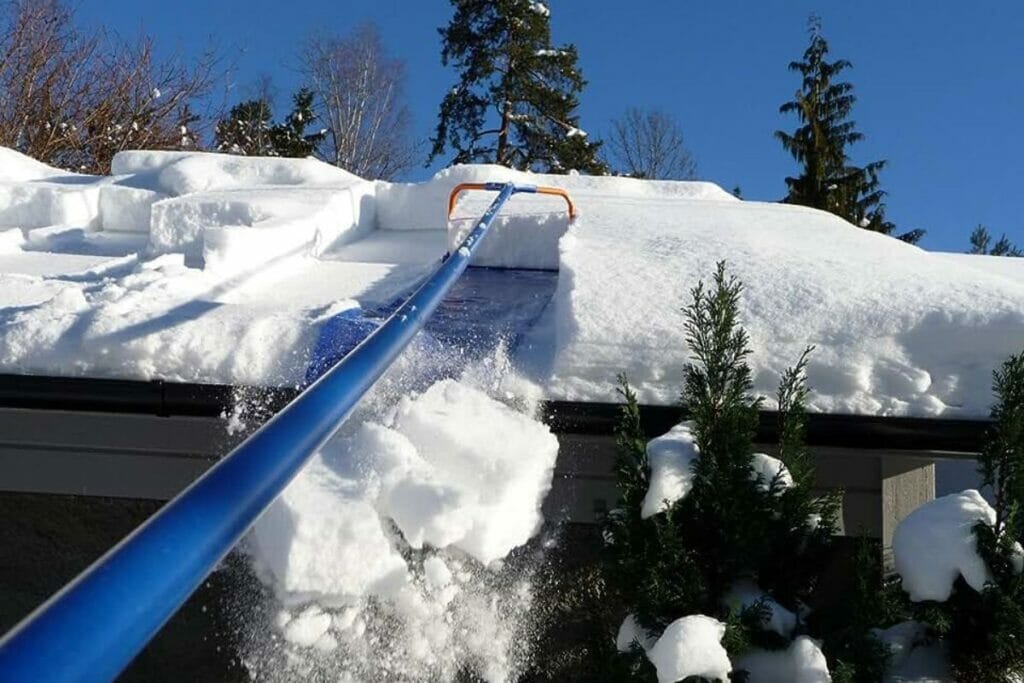A roof rake is a tool to remove snow and ice from the surface of a roof. It consists of an aluminum handle with telescoping poles that you can extend to reach up onto high roofs. It has a plastic or metal scoop or a broad blade at one end that you can push or pull across the roof surface.
The scoop breaks packed snow and ice, then you drag the rake down the roof to pull the snow away from the surface. You can also use roof rakes for cleaning gutters and removing leaves or other debris from roofs. Roof rakes can damage your roof if not used properly. Keep reading to learn how it happens.
SHINGLED ROOFING
Shingle roofs are delicate and made up of three layers. The base layer consists of fiberglass matting which gives the shingle strength. The mid-layer comprises asphalt, which prevents water and moisture penetration. The top layer consists of granules that add color to the roof and protect the asphalt from UV rays.
Raking your roof scratches and tears the shingles if you drag snow or debris across the surface. Raking scraps of the ceramic granules makes the asphalt dry out. Dried asphalt loses its pliability to hold more granules in, thus making it crack. Cracked asphalt allows water infiltration into your house.
SAFE USE OF A ROOF RAKE

When using a roof rake to remove snow and ice from your roof, it is essential to use one with rounded edges. This will help to prevent scratches, tears, and other damage that can occur when scraping the surface of the shingles. Gently pull the rake towards you while brushing the surface of the shingles. Too much force when tugging on the rake can result in tearing or ripping off the shingles, potentially damaging them beyond repair.
When clearing debris from your gutters, it is important to be gentle and aware of any obstructions near the gutter area. Electrical wiring can be a particular hazard when removing debris from gutters and should be avoided. You should also be aware of any other objects or materials in the gutter’s way and take extra caution to avoid damaging them. If snow accumulates higher than two feet, we highly recommend hiring a professional for snow removal from your roof. A certified and experienced contractor will safely remove the snow from your roof without damaging shingles or gutters.
HOW TO USE A ROOF RAKE ON A PITCHED ROOF
We recommend clearing snow and ice in sections on a pitched roof rather than all at once. Begin at the roof’s edges and rake up to 6 feet from the edge. Do not pull back forcefully or press down the rake. The idea is not to scrape the roof clean but to minimize the snow depth. Be sure to stand securely to avoid slips or falls while using the snow roof rake. Do not climb up a ladder because you could easily slip. The roof rake design only allows you to use it from the ground.
Keep the angle of the roof rake parallel to the roof’s pitch when removing snow and ice. Use a curved rake specially designed for the job to avoid roof damage. Keeping the rake angled ensures that snow slides off with ease. After raking your roof, clear the downspouts and gutters of any water, snow, or debris. Standing water will freeze and burst the downspouts. Be cautious not to rip off drains and gutters.
SAFETY MEASURES WHEN RAKING YOUR ROOF
Cleaning your roof keeps your home safe and in good condition. It prevents damage from the elements, such as wind, rain, snow, and ice, and improves the look of your home. However, raking your roof can be a risky task, and it is important to take the following necessary safety precautions.
ROOF INSPECTION
Before it snows, call Paramount Roofing to conduct regular roof inspections to ensure your roof is in perfect condition. We will also repair any damage to prevent further wear and tear. Roof inspections repair loose gutters or wobbly shingles. Catching any of them with a roof rake causes damage you cannot repair in the snow.
SAFETY GEAR
Always wear safety gear before raking your roof. Safety goggles, sturdy shoes, thick gloves, and a helmet are necessary to keep you safe. Raked snow falls toward you, so you must watch out for heavy snow and icicles that can harm you. Protect any shrubbery under your eaves from the falling snow. Avoid any power lines bringing power into your home and any other wiring connection on the roof.
CONSIDERATIONS BEFORE PURCHASING A ROOF RAKE
Before purchasing a roof rake, there are several important considerations to keep in mind. You must research the size and type of roof rake that is suitable for your particular roof. Consider factors such as head design, weight, length, and material.
MATERIAL
Polyethylene is an incredibly versatile and resilient material, making it a perfect choice for the head of a rake. It is tough and weather resistant and stands up to wear and tear from frequent use without easily cracking or breaking.
Fiberglass is a material that has many beneficial qualities, making it an ideal choice for the shaft of a rake. It is lightweight and durable, which allows the rake to be easily maneuvered without having to worry about its strength or weight.
Aluminum is an ideal material for a rake, as its durability and strength far surpass that of polyethylene. An aluminum rake with wheels will effectively clean debris from your roof without damaging the shingles.
Wood is an excellent material for the shaft of a rake because it is strong and relatively lightweight, making it easy to use. Additionally, wood can be easily sourced and is usually inexpensive compared to other materials.
HEAD DESIGN
Roof rake heads vary in design and rake depth. They range from 3 to 10 inches deep and 12 to 24 inches wide. Larger rake heads remove more snow but can cause arm, back, and shoulder fatigue. Choose a roof rake with interchangeable attachments such as a slide, scoop, or blade for different uses. Curved heads are easier to maneuver and cause less damage to the roof. Rake heads with wheels or bumpers protect the roof from harm, especially aluminum or blade rake heads.
WEIGHT AND LENGTH
Choose a snow roof rake with an adjustable pole. The ideal one should extend up to 22 feet and shorten to less than 8 feet for proper storage. Longer poles enable you to reach higher on the roof. However, they might be bulky and necessitate more strength to maneuver.
Most of the weight in a roof rake is on its head. The heavier the head, the more likely it is to sink further into the snow. Sinking deep allows you to remove more snow per rake pull. Heavy rake heads call for more physical strength to position and lift.
Paramount Roofing is a roofing service company in Romeo, MI. We have certified roofing professionals that offer outstanding roofing services to our clients. A good roof saves your energy costs and lasts longer while protecting your home from weather elements. Our high level of craftsmanship ensures you get quality service. Our services range from roof insulation, gutters, skylights, air vents, and siding. We also conduct roof repairs, inspections, replacement, and maintenance. Contact Paramount Roofing today for more information on roofing services and repairs.
 Free Estimate
Free Estimate
 Request Service
Request Service Locations
Locations 
